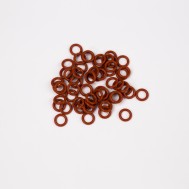Liquid silicone rubber (LSR) is a unique material that has many distinguishable benefits for a variety of applications. With a presence in industries like medical, aerospace, automotive and electronics, LSR is an extremely sought after rubber material.
This versatile, high-quality rubber has made its mark in the sealing industry. Apple Rubber utilizes many technologies and processes to fully take advantage of its benefits, manufacturing everything from simple seals to complex rubber parts. To truly become an LSR expert, here are 10 major benefits that you need to know:
1. Great Resistance
LSR has a high resistance to water, ozone and weather, making it a great sealing material for outdoor applications that may be exposed to various weather conditions over an extended period of time.
2. Medical Grade Properties
The medical industry has very strict guidelines for the materials and devices they use. Rigorous sterilization processes and biocompatibility testing are required in order for a material to be accepted as medical grade. LSR is able to be stripped of extractable and successfully applied in various medical applications.
3. Self-Lubricating
LSR can be mixed in specific ways to adopt desirable characteristics. In order to make the rubber self-lubricating, incompatible fluids are mixed into the silicone components. Once the rubber cures, the liquids will rise to the surface, creating a slippery, lubricating texture.
4. Food Grade Capabilities
Food grade LSR is favorable in many different applications because it is tasteless, odorless, naturally transparent and maintains its mechanical properties over time. Food grade LSR is often used in baby care products, household utensils and gaskets and seals for cooking appliances.
5. Thermal Stability
LSR has high thermal stability and can withstand extreme temperatures ranging from -85° to +400°F. LSR also retains its flexibility at low temperatures, making it an ideal sealing solution for applications exposed to the cold.
6. Electrically Conductive
By adding conductive-grade carbon black to LSR components, electrically conductive LSR is formed. This grade has very high-functioning mechanical properties and can resist down to 9 ohm-cm volume.
7. Reduced Cycle Times
With fast cure times, LSR can be produced quickly and in large quantities, making it easy for manufacturers to mass-produce LSR parts. By controlling the number of functional groups that are added to the cure site, LSR experiences higher reactivity that quickens the pace of cure.
8. Services the Automotive Industry
Chemical and temperature resistance allows LSR to be a resourceful sealing material for a variety of automotive applications. Some of the most popular include comfort and driving assistance parts, engine components, seals for data connectors, headlight gaskets and LED diffusers.
9. Sanitary Solutions
LSR is hypoallergenic, mold-resistant and mildew-resistant, making it a desirable sealing material for any industry with strict sanitation guidelines. Often used for consumer products, some of the most common places to find LSR include showerheads, dishwasher gaskets, cooking utensils, cleaning supplies and items used for bathing.
10. Easily Pigmented
LSR is naturally a clear material, allowing customers to choose their preferred color. Adding color pigment to LSR is generally a simple task and does not change the chemical properties of the material.
Want to talk more about LSR?
Tweet us @AppleRubber to continue the conversation.
